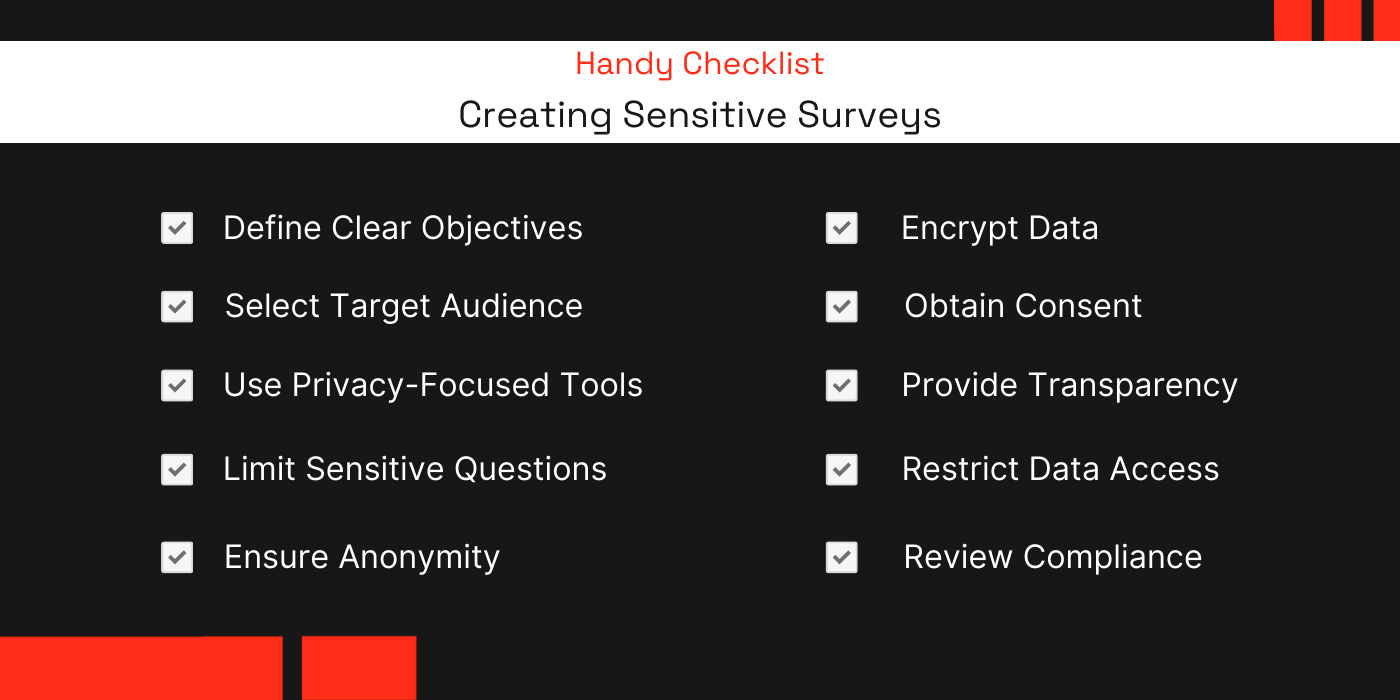Get insights.
Unlock value.
- 14-day free trial
- Set up in minutes
- No credit card required
How To Run Sensitive Surveys
Looking for a way to collect sensitive data? Does your survey ask sensitive questions? No matter what type of survey you are crafting, being mindful of what and how you are asking your questions is important.
By doing so you can build trust with your participants and get accurate insights. It is more crucial when you are collecting sensitive information.
Personal topics like mental health, addiction, abuse, and trauma are delicate by nature. These topics help researchers, social workers, and clinical psychologists to gather real insights and create support systems.
When people expose sensitive and secret parts of their lives, they should feel secure. So sensitive topics need extra care and security to get honest answers.
Pre-Survey Preparations - Things to keep in mind
Pre-preparations that can cut sometime before the launch of a sensitive survey:
Transparency - Be open about the goal of your survey, how you will use that data, and how it assures privacy.
Anonymity - Participants should be able to provide anonymous responses.
Comfort and accuracy - Do not ask questions that people may find awkward and allow them to skip if possible.
Stop using personalized questions - Ask for personal information only when it is needed. You want them to feel comfortable not exposed.
Best Practices for Conducting Sensitive Surveys

So, a sensitive survey requires some planning before conducting it. Follow these best practices to make it comfortable to answer and to get real answers.
Choose the right tool: Opt for privacy-focused safe and secure platforms like BlockSurvey that value data protection and keep it confidential.
Avoid unnecessary Questions: Ask only questions that are related to the topic. All questions must serve a purpose.
Option to skip: Provide users with the ability to skip any question they may be uncomfortable answering. Making them answer can cause discomfort.
Give Instructions: Everything should be clear to participants. This reduces distress and develops trust.
A Mobile-Friendly Design: Since much of the responses are collected by surveying users on their phones, it is essential to keep it mobile-friendly to increase completion rates.
Simplify the language: There is no need for jargon or complex language. Questions should be easily understood by participants and allow them to answer honestly with some thought.
Pilot your survey: Do a small pilot test with volunteers to find any issues and make changes accordingly.
Stick to ethical guidelines: Respect participants' rights, and follow ethical guidelines throughout the survey process. Communicate the survey terms and get consent before data collection.
Distribution and Storage: Distribute the survey through secure channels to protect respondents' data and ensure it reaches the intended audience. Store the collected data securely with encryption to maintain confidentiality and prevent unauthorized access.
Use Cases
Survey on Child Abuse: The purpose of this survey is to provide a way for researchers and social workers to collect important information related to child abuse in an attempt to identify patterns or potential areas that may need intervention.
Conners ADHD Rating Scale: This survey is suitable to assess the symptoms of ADHD in children and adolescents by conducting a detailed behavioral and psychiatric assessment which would help maintain privacy as well as authentic feedback.
How BlockSurvey Can Help?
BlockSurvey is a privacy-first way to create surveys. It offers encryption along with anonymity to keep the data secure and private. From survey creation to analysis to insights, every step of the process is safe and secure with end-to-end encryption. By using a secure survey platform like BlockSurvey, you can focus on gathering real insights without compromising on respondent's privacy.
BlockSurvey’s commitment to privacy ensures that sensitive information remains confidential, building trust between you and your participants. With high-level security features and a user-friendly interface, BlockSurvey enables you to craft surveys with privacy and accuracy.
To Wrap Up
Sensitive surveys are essential for uncovering valuable insights into complex and often painful areas of life. But with this work comes a great responsibility to protect participants and handle their data with care. By prioritizing confidentiality, transparency, and comfort, and by using the right tools, you can conduct sensitive surveys that truly respect and protect your respondents.
Read this blog to learn more about the importance of using secure survey software.
How To Run Sensitive Surveys FAQ
What is a sensitive survey?
A sensitive survey addresses delicate topics like mental health, addiction, or trauma, requiring extra care in design to ensure participant comfort and privacy.
How does BlockSurvey ensure the privacy of sensitive data?
BlockSurvey uses encryption and anonymity features, ensuring that the data collected remains secure and untraceable to individual respondents.
Why is it important to allow participants to skip questions in sensitive surveys?
Allowing participants to skip uncomfortable questions helps reduce stress and ensures they feel safe, which can lead to more honest responses.
Can I use a sensitive survey for workplace-related issues?
Yes, sensitive surveys can be used in the workplace for issues like employee mental health, but it's crucial to ensure anonymity to encourage honest feedback.
What should I do if a participant discloses distressing information during a sensitive survey?
Have a plan in place to provide resources or support, and ensure that the survey platform and process protect the participant's identity and privacy.
Get insights.
Unlock value.
- 14-day free trial
- Set up in minutes
- No credit card required



